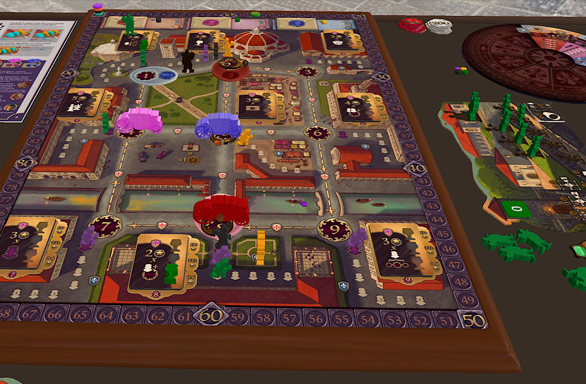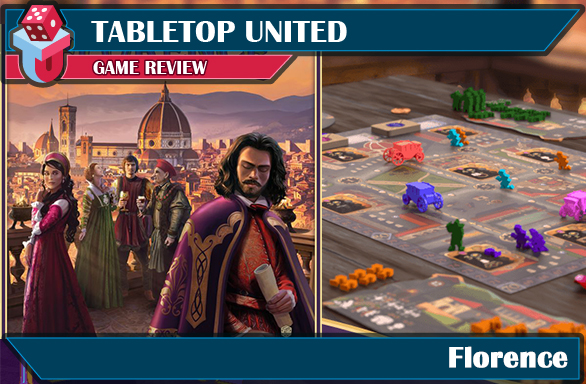
Mi scusi, I have a date with the Medici!
Designer: Dean Morris
Artist: Dann May
Publisher: Braincrack Games
Year Published: 2021
No. of Players: 1-5
Ages: 14+
Playing Time: 40-80
Main mechanic / Theme: Area Control, Euro-Style, Worker Placement
Fortune favors the braggadocious!
Find more info on BoardGameGeek.com / Kickstarter
Disclaimer: Publisher provided a copy of the game for this review.
Overview:
Social capital is key in this Renaissance era power struggle between rival families. As the player, you deploy family members to various parties happening around the city of Florence to curry favor with the 3 Medici, each of whom peruse the different locations and bestow victory points based on various aspects. Every turn is a carefully calculated cavort that rewards premeditated calculations. Fans of heavier euro games will be drawn to the flavorful Italian theme and deep well integrated mechanics.
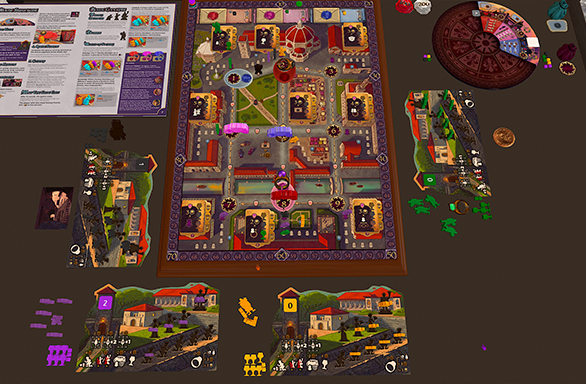
Gameplay and mechanics:
Florence has many interconnected mechanics, each with their own variable points, so it can be pretty overwhelming to make even one play. Time is your resource, and you use it to perform a variety of actions like deploying, moving, gifting, bragging, and upgrading. The game utilizes many game mechanics like area control, worker placement, set collection, and route building. The main mechanic revolves around maximizing points according to the expected routes of the 3 Medicis. You do this by utilizing every mechanic in the game at the most opportune time; like positioning your family in the most ideal locations, or lacing guards in the most frequented streets, or fulfilling high value brags before anyone else. There are so many considerations to make with every move. Even passing your turn is an important choice with many implications! Fans of efficiency mechanics will feel good chaining many deliberate actions.
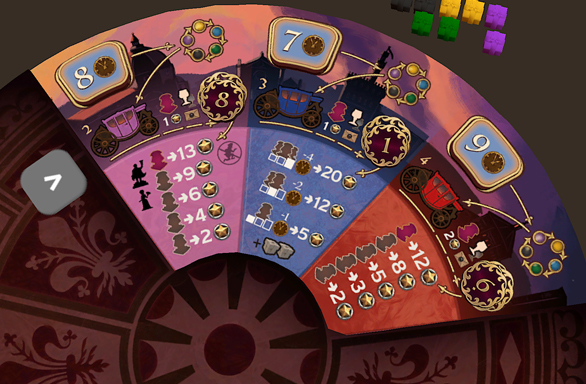
Theme, Artwork and Illustration, Graphic Design and Layout:
From an aesthetic perspective, this is a stunning game. It has a classy presence and thoroughly implemented theme. As a professional graphic designer and illustrator myself, I can tell every graphic decision was made with the utmost consideration. A particularly noteworthy bit of graphic design is the circular timetable spinner. It can be quite intimidating to read, and though there are a few icons that could be redesigned for clarity, it is on the whole successful at illustrating very complex mechanics. It’s a good thing too, because your group will spend a lot of time huddled around this particular component to plan turns. Once your group has deciphered the graphics, turns become much easier to parse. The map does a good job at balancing utility and ornamentation, but there are a few places I wished had a few player reminders or aids.
Inclusivity and Accessability:
Tabletop United believes that diversity is a source of fun and happiness. Nurturing and celebrating our personal differences can lead to amazing gaming (and life) experiences.Therefore, TTU is putting renewed emphasis on inclusivity and accessibility by adding a section in each of our reviews written after April 2021. You’ll begin to see more reviews with this section as time goes on. The inclusivity and accessibility section will critique those issues and strengths of the subject in the review based upon the unique background of the reviewer. Each reviewer views the world through their own particular lens and has a wide and varied experience from which they will write and review from.
I studied Italian culture, art, and language for four years at a university level, and can view this game with extra contextual knowledge about Renaissance culture. I appreciate the palazzi (palace houses), Duomo (Florence cathedral), and ponti (bridges) that bring the player into the setting. The game stays largely abstract about the humans involved in the game. Other than the Medici themselves, there is no representation of the players nor family members aside from abstract colored meeples. The scandal cards have bits of flavor text in Italian, which was a very cute touch. From a cultural and historical perspective, the game is a respectful implementation of the subject of the Medici in Florence.
An issue of color blindness arose in my play session regarding the coloring of the Medici, where it was difficult for a player to discern the colors of the carriages. We had to increase saturation on some of the pastel colors. This issue may be a result of the TTS implementation. The physical game may print in colors that avoid this issue.
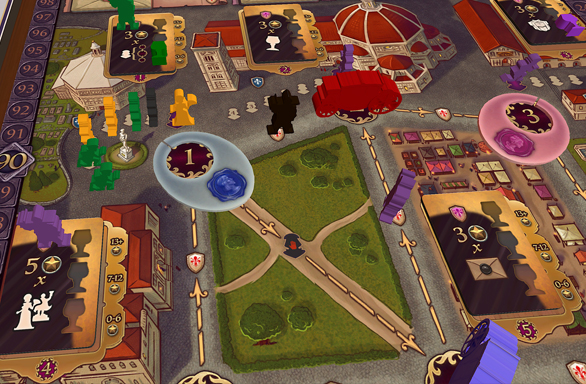
What worked:
The game largely manages to juggle many scaling mechanics very well. My play groups all agreed that it felt like a heavily tested and polished game. For gamers that appreciate extrapolating several moves ahead and crunching a few numbers, this game will reward you with high point plays. There are however, a few mechanics like scandal and scheme cards that keep the game from being too fatalistic. This is a very tight and well produced game that will shine both on your shelves and table. I can see it being a favorite game in the right group of players, and that’s saying a lot considering the saturated market.
Final thoughts:
This game will be welcomed by veteran gamers and especially by those who enjoy titles like Scythe, Power Grid, and Terraforming Mars. My group considered it a medium-heavy title that may require a “throwaway game” as a cooperative teaching session. My biggest criticism for the game is definitely with new player uptake. The game throws every mechanic at you all at once in the beginning, and it is hard simply figuring out what actions give you points, let alone timing and efficiency. Not only is it a lot to take in all at once, new players will get summarily crushed by more experienced gamers every time. There are virtually no “catch up” mechanics and advantage is built incrementally, so if you mess up your early turns or misunderstand one of the many mechanics, it will be hard to come back. Would definitely welcome a “teaching game” written into the rules and maybe a player aid. It is because of this that our group ended up playing it three times to understand the game enough to form an opinion. Despite the struggles of the first game, it left all of us impressed by the depth, breadth, and presentation, once we had been initiated.
